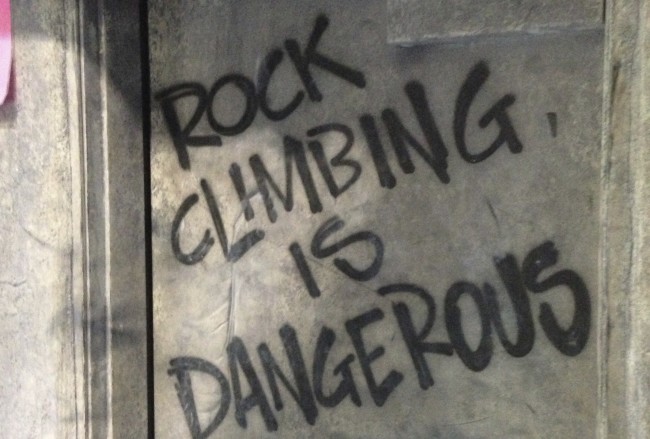
By Bill Zimmermann
There is a lot of discussion of “risk” and “risk management” in the climbing industry. However, when professionals are pressed to define what they mean by these terms, you’re likely to get a bewildering array of definitions. I’ll attempt to provide you with some relatively straightforward definitions and help you understand some of the fundamental strategies used to deal with risk in a recreational setting.
Risk
First, what do professional risk managers mean by the term “risk”? The word simply means the “possibility of loss or injury; the probability of such loss; or someone or something that creates or suggests a hazard.” The risks that we are concerned about in the operation of our types of businesses are: loss of income, loss of property, damage to property, damage to reputation, injury, and death.
So, what questions would one need to ask to be able to evaluate a risk? How do we decide what risks are important? In analyzing or evaluating risks it is essential to ask three related questions: What is the probability that this risk will occur at all, with what frequency, and with what severity? Simply ask yourself what risks are likely to occur, how often, and what would be the consequences of those things happening to me or my business. Attention should probably be paid to risks or incidents that occur frequently or whose severity would be high.
Risk Management
Risk management is a discipline employed to deal with uncertainty. As a discipline it provides an overall framework and specific strategies to identify and confront virtually all reasonably foreseeable risks. Risk management involves these steps:
- Identifying the organizations mission, goals, and programmatic context
- Identifying the reasonably foreseeable risks associated with the organization’s mission, goals, and operations
- Evaluating and prioritizing those risks based upon frequency and severity
- Mitigating the risks using general risk management strategies
- Developing a risk management plan (often a written document or set of documents)
- Monitoring and adapting your plan to changing conditions
Analysis and management of risk is a proactive approach to preventing or reducing all types of incidents, injuries, or losses. Practically speaking, A risk management system can be thought of having three aspects: identification, mitigation, and monitoring.
Risk Management Strategies
Once risks have been identified, there are four basic strategies generally employed to address them:
- Elimination. Some risks can be eliminated by avoiding or discontinuing an activity altogether. Risks that are deemed to be too great or “unacceptable” should be eliminated. Avoiding risks involves identifying occurrences beforehand and modifying your activities accordingly. An example of this strategy might be discontinuing the use of certain techniques or equipment in a climbing gym (eg. not allowing patrons to tie in with bowlines).
- Reduction. Many risks cannot be eliminated, some are unpredictable (e.g. lightning or “acts of God”) and some are inherent. Inherent risks are those that cannot be eliminated without changing the nature of the activity itself. Many risks attendant to adventure programming are inherent, they are obvious and unavoidable. Furthermore, the presence of inherent risk in some activities contributes to their value and, one could argue, should not be eliminated. Risks that cannot be eliminated can be managed by minimizing the frequency and/or severity of occurrences. An example of this strategy might be making sure that the climbing facility has a sound belay training and testing protocol in place for clients.
- Transfer. Transfer is a strategy that attempts to re-allocate financial or legal risk to another party by means of a contract. Examples include: purchasing appropriate types and levels of insurance and employing legal documents such as assumption of risk, releases, waivers, indemnity agreements, covenants, etc.
- Retention. This strategy is the keeping of all or part of the risk. For example, one might understand the risks associated with an activity and continue to engage in it regardless of the risks. Presumably there is some compelling purpose, rationale, or justification for retaining risk. Retention is a strategy of acceptance, and in our industry of personal responsibility. As a business owner, you want to be clear with your clients regarding the nature of the risks they should be willing to assume. If they are not willing to assume the requisite risks, then they should not be your clients.
Practical risk management can be boiled down to a simple methodology that includes identification of the reasonably foreseeable risks and prevention, prevention, prevention. When we learn some very simple methods to identify and analyze risks, those risks become much easier to see, understand, and avoid.
This article was excerpted with permission from: Bill Zimmerman, Chief Executive Officer of the Climbing Wall Association.
Read the full article here: Risk Management 101: Four Fundamental Risk Management Strategies

Climbing Business Journal is an independent news outlet dedicated to covering the indoor climbing industry. Here you will find the latest coverage of climbing industry news, gym developments, industry best practices, risk management, climbing competitions, youth coaching and routesetting. Have an article idea? CBJ loves to hear from readers like you!







